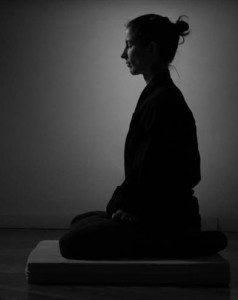 What is zazen?
What is zazen?
Everybody knows that Zen practice is largely about zazen, literally, “sitting zen” – but what is zazen?
Through the ages, there has been a lot written about the subject, especially for a bunch that has spent so much time sitting down and shutting up. I got the bug for this inquiry (what is zazen?) from Katagiri Roshi. It involves investigating the ancient sayings, drilling in, and seeing how the ancients regarded this practice of sitting, and other dharma issues too, through study of dharma texts and exploring what’s written through the personal experience of zazen. Today, a friend called this as an “academic” pursuit, however, for me it hasn’t been (in the sense of it being intellectual and divorced from practice).
Dōgen’s Fukanzazengi (普勧坐禅儀) or Universal Recommendations for Zazen is one of the important sources for inspiration in this regard. This text is chanted every evening after zazen in many Sōtō training centers. Click here for one translation.
As I was saying, some moderns say Dōgen’s recommendations for zazen didn’t recommend much, didn’t answer the question “what is zazen?” other than instructions for posture and “breathe softly through the nose.” However, there are these four characters: 公案現成. The Sōtō Zen Text Project translation, linked above, has this as a translation: “It is the kōan realized.”
The translators have graciously added the first three words – “It is the” don’t appear in the Dōgen text. He just laid it out – “kōan realized” – as a recommendation for zazen, as an answer to the question, “What is zen meditation?”
“Kōan” here is composed of 公案 and means simply “public” and “case” – this one universal particular world (the call of the oriole, the beep of the tea pot). Individually, the next two characters 現成, the “realized” part of “kōan realized,” mean “appear” and “completed.” In contemporary Chinese, the two characters together mean “ready-made.”
Genjō kōan and kōan genjō
This might sound familiar to you card-carrying Dōgenophiles. In Japanese, these four characters would be pronounced “kōan genjo.” Yes, just like in Dogen’s well-known essay, Genjō kōan, but with a difference in the order of the characters, and despite being pronounced the same, one of the characters is different – the “an” in “kōan.”
In Genjō kōan, instead of the usual character 案 for “case,” Dōgen used 按 – also pronounced “an” in Japanese. Senne, Dōgen’s direct disciple (as translated by Okumura Roshi) said the 案 “an” in Genjō kōan means “to keep one’s lot.” Both characters express an aspect of the so-called “relative,” but Dōgen’s playful choice for the “an” in Genjō kōan, 按, emphasizes the importance of taking responsibility and clear boundaries.
The usual way of writing “kōan,” 公案, by Dōgen’s time, the thirteenth century, was an integral part of all Zen/Ch’an (and Korean Sŏn) practice. “Kōan” was an established technical term referring primarily to a set of literature, the public cases that recorded encounter dialogues mostly from Zen/Ch’an masters, mostly from the eighth and ninth centuries. These encounter dialogues were frequently used for public presentations and as subjects of meditation, including by Rujing, Dōgen’s teacher in the Sōtō/Caodong lineage. For more on this, see my previous post, “The Mu Kōan and How Some Zennists Just Wanna Have Fun.”
Dōgen demonstrated incredible fluency with this literature in both his collected works, Shobogenzo and Eihei koroku. In the Fukanzazengi, Dōgen used the usual characters for “kōan” 公案, referring primarily to this body of literature.
It is widely agreed that Dōgen was not a guy prone to fling characters about wantonly. He seems to have focussed the whole of this great mind and heart on how to express the great matter. It could also be said that writing was one of the ways Dōgen embodied practice-enlightenment. So there must be some reason for his use of the standard characters for “kōan” when talking about zazen.
Just the facts (and a question)
In Genjō kōan, Dōgen playfully switched up the character for “kōan” with a character, also pronounced “an,” “keeping one’s lot,” that emphasizes taking responsibility and clear boundaries. In Fukanzazengi, when giving instructions for zazen, he used the characters that were used in China at the time to refer to the body of literature called “kōan” or “public case.”
Dōgen said simply and clearly that the zazen he’s talking about, recommending universally even, is this kōan realized. Perhaps he meant the kōan realized, the essential kōan at the heart of all kōan. The essential kōan, however, doesn’t appear abstractly, apart from context, but arises in particular kōan after kōan.
I’ll leave you with this question: If zazen is the kōan realized, is it necessary to realize kōan in order to do zazen according to the way that Dōgen recommended?
——












